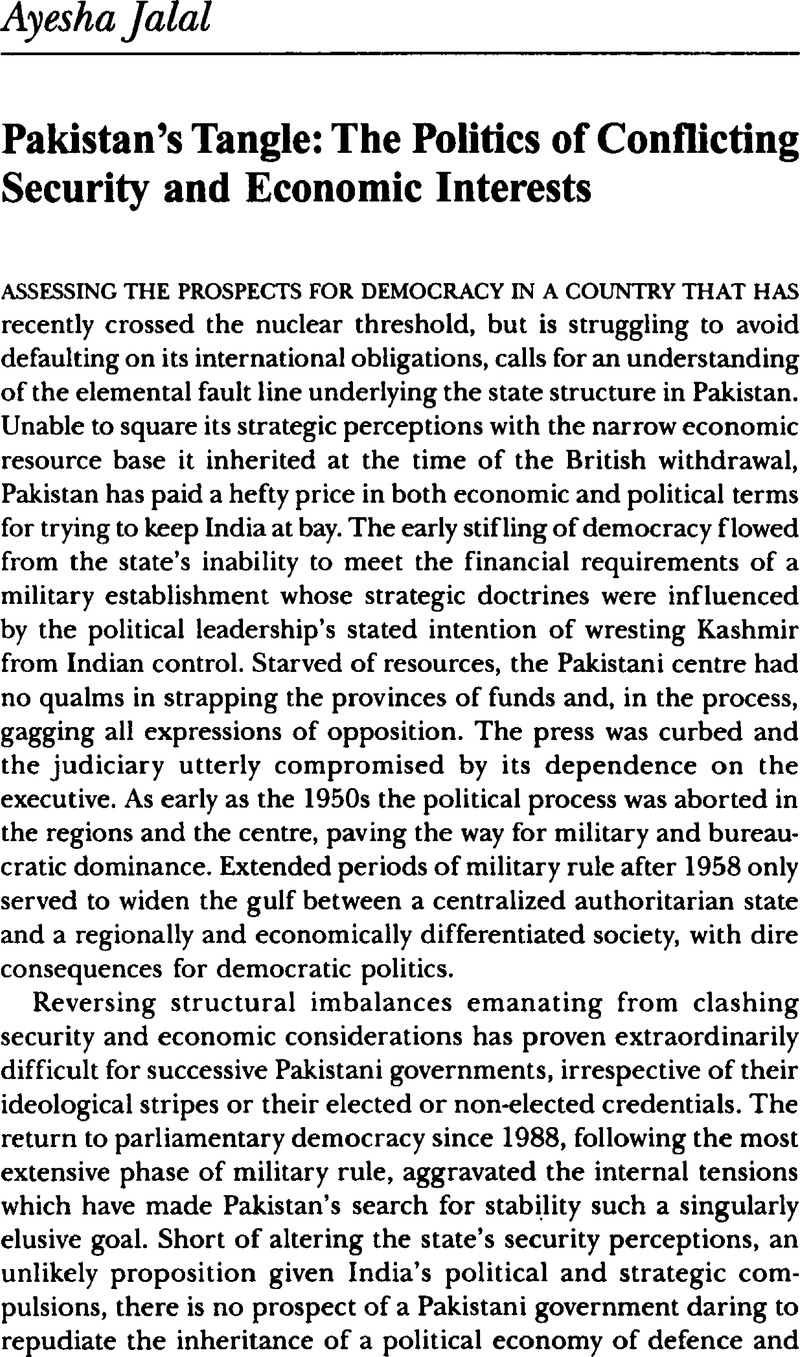Article contents
Pakistan’s Tangle: The Politics of Conflicting Security and Economic Interests
Published online by Cambridge University Press: 28 March 2014
Abstract

- Type
- Articles
- Information
- Copyright
- Copyright © Government and Opposition Ltd 1999
References
1 A colourful Habibie biography, written by an assistant, is Makka, A. Makmur, BJH: Bacharuddin Jusuf Habibie, His Life and Career, 3rd ed., Jakarta, Cidesindo, 1996.Google Scholar
2 Huntington, Samuel P., The Third Wave: Democratization in the Twentieth Century, Norman, Oklahoma and London, University of Oklahoma Press, 1991.Google Scholar
3 For example, Liddle, R. William, ‘Indonesia: Suharto ’s Tightening Grip’, Journal of Democracy, 7:4 (10 1966), pp. 58–72.CrossRefGoogle Scholar
4 The classic list of variables is in Dahl, Robert A., Polyarchy: Participation and Opposition, New Haven, Conn., Yale University Press, 1971 Google Scholar. A contemporary version is Diamond, Larry, Linz, Juan and Lipset, Seymour Martin, Democracy in Developing Countries, Boulder, Colorado, Lynne Rienner, 1989.Google Scholar
5 For an extended discussion, see R. William Liddle, ‘Coercion, Cooptation, and the Management of Ethnic Relations in Indonesia’, in Brown, Michael E. and Ganguly, Sumit (eds), Government Policies and Ethnic Relations in Asia and the Pacific, Cambridge, MIT Press, 1997, pp. 273–320.Google Scholar
6 Indonesia’s Muslim population (86 per cent of the total) can be divided into three groups: abangan, traditionalist and modernist. Abangan is a Javanese term, applied to Muslims whose religious beliefs and practices are more animist and Hindu than Islamic. Traditionalists are pious Muslims who adhere to the Syafi’i school of jurisprudence in Sunni Islam. Modernists are pious Muslims who reject the jurisprudential schools and their reliance on the authority of religious teachers/scholars, the ulama. Instead, modernists emphasize the believer’s right to interpret the Qur’an directly. These distinctions were first made by Clifford Geertz in The Religion of Java, Glencoe, The Free Press, 1960. In recent decades there has been a general tendency for abangan to become pious Muslims. The boundaries between modernist and traditionalist have also become blurred, largely under the influence of modern Western‐style schooling. None the less, the categories remain politically significant. There is also a growing number of secular Muslims who do not affiliate with any religiously‐based political organizations.
7 Moertono, Soematsaid, State and Statecraft in Old Java, Ithaca, New York, Cornell Modern Indonesia Project, 1968.Google Scholar
8 Salim, Said, ‘Suharto’s Armed Forces: Building a Power Base in New Order Indonesia, 1966–1998, Asian Survey, 38: 6 (June 1998), pp. 535–52.Google Scholar
9 Robert Cribb (ed.), The Indonesian Killings 1965–1966, Clayton, Victoria, Monash University Centre of Southeast Asian Studies, 1990.
10 Soebijono, , Tambunan, A. S. S., Mukmin, Hidayat and Astoeti, Roekmini Koesoemo, Dwngsi ABRI, Yogyakarta, Gakjah Mada University Press, 1997.Google Scholar
11 ‘ Undang‐Undang Dasar Negara Republik Indonesia Tahun 1945’, in Padmo Wahjono, S. H., Negara Republik Indonesia, Jakarta, Rajawali, 1982, p. 145 Google Scholar (my translation).
12 This argument is examined more fully in William Liddle, R., ‘A Useful Fiction: Democratic Legitimation in New Order Indonesia’, in Taylor, Robert (ed), The Politics of Elections in Southeast Asia, Cambridge, Cambridge University Press, 1996, pp. 34–60.Google Scholar
13 The phrasing is taken from the Preamble to the 1945 Constitution. See Padmo Wahjono, op.cit., p. 144 (my translation).
14 ‘Laporan Stenografi Amanat Presiden Soeharto pada Malam Ramah Tamah Dengan Pengurus KNPI 19 July 1982’, Jakarta, , 1982 Google Scholar, typescript. This is an unofficial transcription of an extemporaneous speech in which President Suharto explained at length to young Golkar leaders the deep historical roots of New Order values.
15 The best account of the formation of ICMI is Syafi’i Anwar, M., ‘Islam, Negara, dan Formasi Sosial dalam Orde Baru’, Ulumul Qur’an, 3: 3 (1992), Supplement, pp. 1–28.Google Scholar
16 A close account of corruption in the 1992 election is ’White Book’ on the 1992 General Election in Indonesia, translated with an Introduction by Dwight Y. King, Ithaca, Cornell Mordern Indonesia Project, 1994.
17 Padmo Wahjono, ibid.
18 Hill, Hal, The Indonesian Economy Since 1966, Cambridge, Cambridge University Press, 1996, p. 15–17.Google Scholar
19 Hill, ibid., p. 193.
20 Salim Said, op.cit.
21 Watch, Asia, ‘East Timor: The November 12 Massacre and its Aftermath’, Indonesia Issues, Nos 17–18 (12 1991).Google Scholar
22 Confidential telephone interview, Jakarta, , 16 05 1998 Google Scholar.
23 Confidential interview, Jakarta, , 08 1998.Google Scholar
24 Interviews with national Golkar leaders Akbar Tandjung, Sambuaga, Theo and Tuswandi, , Jakarta, , 22–24 08 1998 Google Scholar.
25 William Liddle, R., ‘Habibie Under Siege? Elections Will Be the Real Test’, The Asian Wall Street Journal, 23 09 1998 , p. 10.Google Scholar The original research was reported in William Liddle, R., ‘Evolution from Above: National Leadership and Local Development in Indonesia’, Journal of Asian Studies, 32:2 (02 1973), pp. 287–309.Google Scholar
26 Kompas, Jakarta, , 21 07 1998 , p. 1.Google Scholar Kompas is the main Jakarta daily newspaper.
27 See for example the cover story on the armed forces and the dual function in Forum Keadilan, Jakarta, , 19 10 1998 , pp. 10–19.Google Scholar Forum Keadilan is a Jakarta newsweekly.
- 4
- Cited by




